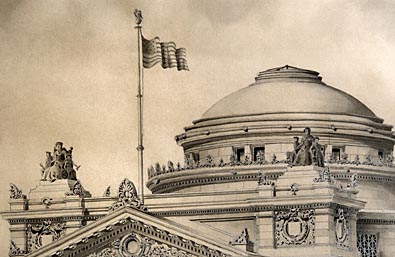Inside Iowa State
Inside ArchivesSubmit newsSend news for Inside to inside@iastate.edu, or call (515) 294-7065. See publication dates, deadlines. About InsideInside Iowa State, a newspaper for faculty and staff, is published by the Office of University Relations. |
February 25, 2005 Beadshear built as statement of permanenceby Anne Krapfl When it was completed in 1906, Beardshear Hall introduced a whole new look to the Iowa State campus. Its limestone, Greco-Roman architecture and grand interior spaces contrasted with functional, red brick buildings (Morrill and Margaret halls, Farm House) that surrounded it at the time. Beardshear recently was the subject of a "Wednesday Walk" sponsored by University Museums. 
Statues in the original drawing for Beardshear Hall (seen at left and right above) were never completed. The 12-foot Greek figures were intended to stand atop four square plinths high above the east and west entrances to the building. Photo by Bob Elbert. "Politically and psychologically, Beardshear Hall was a statement on permanency," said museums director Lynette Pohlman. "The first 40 years of the university had been tough, financially, but this building said, 'We're going to be here awhile.'" Beardshear's large columns and central dome are typical of the Beaux Arts style (a subset of Ancient Greek and Roman styles). The style was inspired by the 1893 Chicago World's Fair, Pohlman said. Subsequent central campus buildings (Marston, Curtiss, Memorial Union and the former Dairy Industry) followed suit, though perhaps not quite as elegantly. Beardshear was to depict authority, and students who attended classes there were to be inspired to learn by its vastness, Pohlman said. One thing not as grand about Beardshear are the round and square interior columns, Pohlman noted. What appears to be granite or marble is colored plaster. From an arts perspective, 12 recent years of renovation in Beardshear restored stained glass skylights in the south roof, added color and 17,000 sheets of gold leaf (weighing a total of 10.7 oz.) to what originally was a white dome, and replaced clear glass in the dome with stained glass. An unfinished project that remains unfinished, Pohlman said, is 12-foot Greek figures intended to stand atop four square plinths high above the east and west entrances to the building. The statues are in original drawings of Beardshear. She's not sure why the statues never were completed, though there are a couple of possibilities. Beardshear was budgeted at $242,000 and cost $417,000 to build. She also knows that the Italian immigrant craftsmen who worked on Beardshear were transferred to a building project in Iowa City and never returned to Ames. Pohlman added, the statues "would have represented knowledge and the notion of 'guarding' knowledge." |
Quote"Politically and psychologically, Beardshear Hall was a statement on permanency. The first 40 years of the university had been tough, financially, but this building said, 'We're going to be here awhile.'" Lynette Pohlman, museums director |